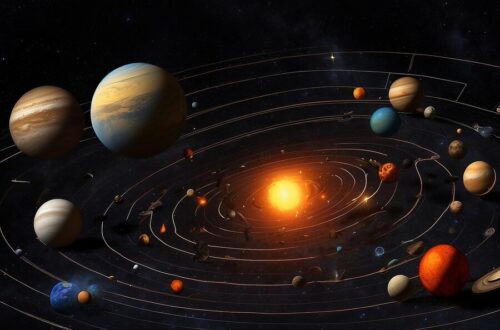The Genesis of the Hellstar Mythos
Before we dive into the scientific or fictional portrayals of Hellstars, it’s essential to understand how the myth began. Ancient civilizations always viewed the night sky as a realm of gods, monsters, and mysteries. Early astronomical observations led to the belief that stars were powerful, sometimes malevolent entities. While most stars represented gods of light or fortune, there were whispers of stars that heralded doom.
Hellstar is a term rooted in the arcane, whispered in forbidden texts and often associated with ancient prophecies of destruction. However, modern interpretations have given it a more defined and terrifying form. The Hellstar is said to be a celestial body with unique properties, defying the laws of astrophysics and behaving more like a cosmic engine of entropy than a star.
Where did this idea originate? Although we can trace references to dark stars or stars of doom in ancient mythologies, the contemporary vision of Hellstar gained traction with the advent of cosmic horror, particularly in the works of writers like H.P. Lovecraft. Cosmic horror deals with the insignificance of humanity in the grand cosmic order, often portraying the universe as indifferent, or worse, hostile to human existence. The Hellstar fits perfectly into this genre—a celestial embodiment of dread that is as incomprehensible as it is terrifying.
Theoretical Astrophysics and Hellstar: A Disturbing Conundrum
From a scientific standpoint, the Hellstar challenges everything we know about the universe. Astrophysicists study stars and stellar objects through the lens of established physical laws, but the Hellstar stands as an anomaly. Traditional stars are bound by nuclear fusion, converting hydrogen into helium, and emitting light and heat. The Hellstar, however, seems to violate these rules.
Theoretically, a Hellstar might not be fueled by nuclear fusion at all. Some speculative theories suggest that it is powered by dark energy or a form of antimatter, allowing it to emit energy in ways we can’t comprehend. Others propose that it could be a form of an ancient or dormant black hole, one that instead of collapsing in on itself, reawakens periodically, draining the life and light from any surrounding star systems.
This eerie possibility has led some astrophysicists to hypothesize that the Hellstar could represent the final stage in a star’s evolution, a “dark star” that no longer emits visible light but still exerts immense gravitational force, pulling everything—including light—into its abyss. Unlike black holes, which are localized phenomena, the Hellstar’s destructive radius could extend for vast stretches of space, influencing the fate of entire galaxies.
What makes Hellstars even more terrifying is their unpredictability. While we can predict the life cycles of most stars, Hellstars, by their very nature, elude understanding. They don’t adhere to observable patterns, and some theories even suggest that they exist outside of time itself, meaning they could appear or disappear at any point in the universe’s history.
Hellstar and Cosmic Horror: A Marriage Made in Nightmares
The Hellstar has found its most vivid portrayal in the realms of cosmic horror and science fiction. Authors have long been captivated by the concept of unknown forces lurking in the vastness of space, waiting to claim unwary travelers or civilizations. The Hellstar perfectly encapsulates this theme—a celestial threat that cannot be reasoned with, escaped from, or even fully understood.
Cosmic horror, particularly the works of writers like H.P. Lovecraft, often taps into the fear of the unknown. The Hellstar is a perfect embodiment of this dread. In Lovecraftian fiction, the universe is not a place of light and understanding but a vast, indifferent expanse where ancient and malevolent entities lie dormant, waiting to awaken. A Hellstar in such a narrative would serve as both a warning and a herald—its arrival would signal not just destruction, but a complete reordering of reality as we know it.
In fiction, Hellstars are often depicted as omens of cosmic cataclysm. Civilizations might look to the stars for guidance, only to witness the appearance of a Hellstar, marking the beginning of their end. The concept of a Hellstar also challenges humanity’s hubris—the belief that we can understand and conquer the cosmos. In many tales, Hellstars symbolize forces that are beyond human comprehension, forces that render all our science and technology meaningless in the face of cosmic annihilation.
The psychological aspect of Hellstars in cosmic horror cannot be overstated. The mere sighting of one could drive entire populations to madness, as its presence suggests that the universe is far more dangerous and hostile than previously imagined. In such narratives, Hellstars are not just physical threats; they represent the existential fear that humanity is not the center of the universe, but rather an insignificant speck in a vast, uncaring cosmos.
Hellstar as a Harbinger of Galactic Apocalypse
What truly sets the Hellstar apart from other cosmic entities is its apocalyptic nature. In many stories and theoretical models, the appearance of a Hellstar heralds the end of entire galaxies. Its gravitational pull, combined with the energy it emits (or absorbs), wreaks havoc on celestial bodies, ripping planets from their orbits, extinguishing stars, and bending the fabric of space-time itself.
If a Hellstar were to enter our galaxy, the effects would be catastrophic. Stars would begin to dim as they are drained of their energy, planets would be torn apart by gravitational forces, and any life forms unlucky enough to be near its path would be instantly annihilated. The Hellstar’s mere presence could destabilize the delicate balance of forces that govern the universe, causing ripple effects that could lead to the collapse of galaxies and even the universe itself.
But Hellstars are not mere agents of destruction; they are also seen as symbols of rebirth. In some myths and stories, the destruction caused by a Hellstar is not the end, but a prelude to something new. After the Hellstar has consumed all energy and life in a galaxy, it leaves behind a barren void—a blank canvas upon which new realities might emerge. This idea, though unsettling, presents the Hellstar as not just a force of death, but also as a force of cosmic renewal.
In this way, the Hellstar embodies the cyclical nature of the universe. Much like the death of stars gives rise to new ones, the annihilation brought by the Hellstar might lead to the birth of new, strange realms of existence, ones that operate under different laws of physics and consciousness.
The Cultural Impact of the Hellstar
The idea of Hellstars has permeated not just science fiction and horror literature, but also pop culture, becoming a popular trope in movies, video games, and comics. The Hellstar is often portrayed as the ultimate antagonist—a cosmic force that heroes and civilizations must rally against to prevent universal annihilation.
In video games, Hellstars are often depicted as final bosses or end-game threats. They might represent cosmic entities that players must defeat or evade, often requiring the harnessing of ancient technologies or forgotten knowledge. These portrayals often tap into the same themes of dread and cosmic insignificance found in literature, reminding players that, in the grand scheme of things, they are tiny specks facing incomprehensible power.
Movies and television have also embraced the concept of Hellstars, particularly in the science fiction genre. They are often used as plot devices to create tension and urgency, driving the protagonists to embark on desperate missions to prevent the Hellstar Shirt from reaching their home planet or star system. The Hellstar’s presence usually signifies the approach of a universe-altering event, adding layers of existential horror to the narrative.
In comics, Hellstars have been used to explore deeper philosophical questions about the nature of the universe and humanity’s place in it. Superheroes and cosmic beings might battle against Hellstars, but these conflicts often end in ambiguity, with the Hellstar’s true nature remaining a mystery. The use of Hellstars in these mediums highlights the enduring fascination with the unknown and humanity’s eternal struggle to make sense of the cosmos.
The Hellstar as an Allegory for Human Fears
At its core, the Hellstar isn’t just a terrifying astronomical object; it’s an allegory for some of humanity’s deepest fears. It represents the fear of the unknown, the fear of destruction, and the fear of our own insignificance in the universe. The Hellstar serves as a reminder that there are forces in the cosmos far beyond our control or understanding—forces that could one day erase us from existence without warning or reason.
It taps into the fear of oblivion. While we often take comfort in the idea that we can understand the universe through science and observation, the Hellstar shatters that illusion. It reminds us that no matter how much we learn, there will always be mysteries lurking in the dark corners of the cosmos—mysteries that could pose a threat to our very existence.
In a broader sense, the Hellstar also symbolizes humanity’s existential dread. It forces us to confront the possibility that the universe doesn’t care about us—that we are not the masters of our own fate, but merely passengers in a cosmic journey that we barely comprehend. The Hellstar’s unstoppable and incomprehensible nature represents the ultimate unknown—the unknowable fate that awaits all of us.
The Eternal Mystery of the Hellstar
The Hellstar stands as one of the most fascinating and terrifying concepts to emerge from both science fiction and theoretical astrophysics. Whether viewed as a nightmarish entity from the realms of cosmic horror or a theoretical astrophysical anomaly, it represents the deepest fears and mysteries of the universe.
While we may never encounter a Hellstar in our lifetimes, the idea of such a phenomenon forces us to reconsider our place in the universe. Are we truly in control of our destiny, or are we merely at the mercy of forces beyond our comprehension? The Hellstar reminds us that the universe is vast, dark, and filled with mysteries that may one day come crashing into our reality.
Read More: Shield Your Patio: The Best Furniture Covers You Can Get for Outdoors in Dubai




